After the decline of the Huns in the second century CE, the next most important nomadic tribal confederation to control a major swatch of Inner Asia was that of the Turks, who rose to power in the 6th century CE and whose original territory encompassed much of Mongolia. The Türk Empire declined rather rapidly but then re-emerged, with its western center being in the region of today’s Kyrgyzstan. When the famous Buddhist traveler-monk Xunzang went west in the 7th century he passed through the territories of the Turk qaghan and wrote about the luxurious silks in which he and his notables dressed. Images of Turk envoys or guards can be seen, dating from about the same period, in mural paintings in Samarkand in today’s Uzbekistan. The Türk Empire flourished in the beginning of the 8th century, at which time we have several important long runic alphabet inscriptions commissioned by its rulers. The collection of the National History Museum contains a reproduction of one of these famous inscriptions from a stele discovered on the Orhon River and material from very recent excavations at a site connected with the burial of Bilgä Qaghan, including striking objects in gold and silver. In that collection, the metal pitchers are of middle-eastern design; we know that such objects were well known in contemporary Tang China, where imitations of their shape were made in ceramic.
One of the most important successor states to the Turks was that of the Uighurs, whose capital in the 8th and early 9th centuries was on the Orhon River in Mongolia, not far from the location where later the capital of the Mongol Empire would be established at Karakorum. The Uighurs initially also used the runic alphabet, although then they switched to a variant of the middle-eastern Aramaic script cursive, the alphabet that then was adopted by Chingis Khan and his successors.


|
Petroglyph depicting Turks (6th-8th c.).
H. 205 cm., W. 58-70 cm.
Munget Khisaa, Aldarkhanu sum, Zavkhan prov.
|


|
Statues purporting to be of Türk ruler Bilgä Qaghan [d. 734] and his wife.
8th c. Marble. Khashaat (Chöshöö Tsaidam), Arkhangai prov.,Orhon R. valley.
|


|
Sculpted head of Türk military leader Köl Tegin (d. 731), brother of Bilgä Qaghan.
8th c. Marble, 42 x 21 x 21.5 cm.
Reproduction of original.
Khashaat, Arkhangai prov.,Orhon R. valley.
Pub.: Dschingis Khan, no. 44, pp. 74-75.
|

|
Fragment of sculpted face (of Köl Tegin’s wife?).
8th c. CE.
Stone. 20 x 20 x 3.5 cm.
Reproduction of original.
Khashaat, Arkhangai prov.,Orhon R. valley.
Pub.: National Museum, p. 16.
|

|
Reproduction of Bugut inscription, from period of first Türk Empire. Original in Checherleg, Arkhangai prov., brought from Bayu Tsagaan region tombs in plain 15 km. S of Bugut mtn. Includes picture of baby being suckled by a wolf.
|
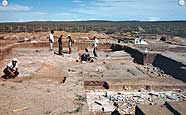
|
Photograph of the joint Mongolian-Turkish excavation of the Bilgä Qaghan/Köl Tegin memorial site, ca. 2003.
Khashaat sum, Arkhangai prov.,Orhon R. valley.
|





|
The inscription honoring Bilgä Qaghan, ca. 734 CE (1st 2 images a reproduction; the rest the original, being restored and cleaned in situ, Khashaat sum, Arkhangai prov.,Orhon R. valley). One of the earliest extended texts in old Turkic.
H.13.33 m.W.1.32 m. Click here for the text of the inscription.
|

|
Miscellaneous objects found in the Bilgä Qaghan treasure in 2001.
8th c. CE (ca. 730).
Khashaat sum, Arkhangai prov.,Orhon R. valley.
|

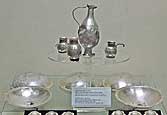




|
Silver objects found in the Bilgä Qaghan treasure in 2001.
8th c. CE (ca. 730).
Khashaat, Arkhangai prov.,Orhon R. valley.
Note the West Asian (Iranian or Sogdian) style of the pitcher and cups. The large circular bowl-shaped objects (approx. 15 cm. dia.) are identified as door decorations. The first three images (2004) show the originals of the table service, the last three apparent reproductions.
|






|
Pitcher, cups, plates; decorative fittings.
Gold.
Pitcher: H. 12.8 cm., Dia. 5 cm.;
Cups: H. 3.29, Dia. 2.42, and H. 3.43, Dia. 3.47 cm.;
Plates: dia. 6.1 and 5.05 cm., Inv. No. U 2003-4-1;
Fittings: dia. 5.23 cm; Inv. no. U 2003-4-7.
Bilgä Qaghan treasure in 2001.
8th c. CE (ca. 730). Khashaat, Arkhangai prov.,Orhon R. valley.
The gold table service in the last two pictures, taken in 2005, is apparently a reproduction; the originals are shown in the other photos from 2004. Pub.: Dschingis Khan, no.51, p. 78; no. 48, pp. 76-77.
|




|
Silver objects found in the Bilgä Qaghan treasure in 2001.
8th c. CE (ca. 730).
Khashaat, Arkhangai prov.,Orhon R. valley.
|


|
Stag.
Silver with gilding.
16 x 12 x 5 cm.
Bilgä Qaghan treasure found in 2001.
8th c. CE (ca. 730).
Khashaat, Arkhangai prov.,Orhon R. valley.
Inv. no. U 2003-4-43.
The first image (2004) is apparently the original, the second (2005) a reproduction.
Pub.: Dschingis Khan, no. 50, p. 77.
|


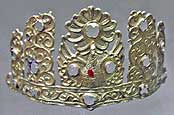




|
Diadem.
Gold with a ruby.
9.8 x 25.7 cm.
Bilgä Qaghan treasure found in 2001.
8th c. CE (ca. 730). Khashaat, Arkhangai prov.,Orhon R. valley.
Inv. No. U 2003-4-46.
The original is shown in first three images (2004), a reproduction in last four (2005).
Pub.: Dschingis Khan, no. 45, p. 75.
|




|
Ornaments and jewelry.
Gold and semi-precious stones.
Very likely all objects are reproductions.
Bilgä Qaghan treasure found in 2001.
8th c. CE (ca. 730). Khashaat, Arkhangai prov.,Orhon R. valley.
Inv. no. U 2003-4-5.
Pub.: Dschingis Khan, no. 47, pp. 76, 78.
|


|
Miscellaneous objects found at Bilgä Qaghan memorial site in 2001-2003. Khashaat sum, Arkhangai prov., Orhon R. valley.
|





|
Miscellaneous objects from Türk Empire period.
6th-8th c. CE.
The bones are probably for divination (one can buy such today in Mongolia).
|




|
Bits and stirrups.
Türk Empire period, 6th-8th c. CE.
Iron.
|

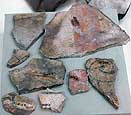

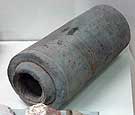

|
Architectural materials and decoration.
Türk Empire period, 6th-8th c. CE, Khashaat, Arkhangai prov.,Orhon R. valley (location of Bilgä Qaghan and Köl Tegin memorials).
|


































































